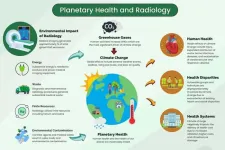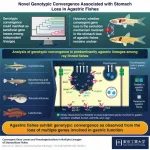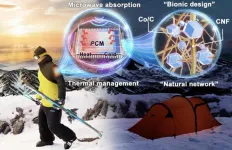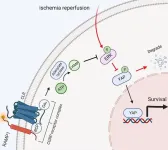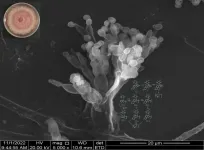(Press-News.org) OAK BROOK, Ill. – A diverse writing group—lead by authors at the University of Toronto—have developed an approach for radiology departments and practices to reduce their greenhouse gas emissions and become more resilient to the effects of climate change. They outlined their action plan in a Radiology in Focus article, published today in Radiology, a journal of the Radiological Society of North America (RSNA).
“Rising greenhouse gas emission levels lead to climate change, extreme weather events and worsening air pollution with downstream adverse health effects,” said lead author Kate Hanneman, M.D., M.P.H., vice chair of research and associate professor at the University of Toronto and deputy lead of sustainability at the Joint Department of Medical Imaging, Toronto General Hospital. “The goal of this article is to increase awareness of the interconnected relationship between planetary health and radiology, emphasize why radiologists should care about sustainability, showcase actions that can be implemented to mitigate our impact and prepare departments to adapt to the effects of climate change.”
Burning fossil fuels and other human activities that increase atmospheric greenhouse gas levels are the primary drivers of climate change. Radiology, through the production and use of medical imaging equipment and related supplies, is estimated to generate up to one percent of overall emissions.
“We propose a coordinated approach and concrete actions radiologists can implement to help sustain the health of the planet and, in turn, improve the health of their communities and patients,” Dr. Hanneman said.
The authors suggest radiology departments begin by establishing a sustainability team and dashboard to track and measure key metrics and performance indicators.
“Departments should build a diverse team that includes all key stakeholders, including radiologists, technologists, leadership, IT and facilities management,” she said. “The individuals and groups impacted by policies and protocol changes should be part of the conversation from the beginning.”
Recommended high-impact interventions to improve sustainability in radiology include transitioning from disposable to reusable medical supplies, turning off climate-control systems in unoccupied areas and powering down equipment when not in use.
Dr. Hanneman said that by switching scanners off or to lower power states when not in use, overall greenhouse gas emissions can be reduced by up to 33% for MRI and between 40% and 80% for CT. Optimizing scanner scheduling can also reduce idle time and reduce the average greenhouse gas emissions per exam for MRI and CT units.
“Utilizing one CT scanner 24/7 with minimal idle time is more efficient than utilizing three scanners from nine to five,” she said.
Another potential action is to implement decision-support tools to choose lower-energy imaging tests when appropriate. Carbon dioxide equivalent, or CO2e emissions, vary by imaging modality and are higher for MRI and CT compared to ultrasound and X-rays.
“When more than one imaging test is appropriate to answer a clinical question, imaging tests with lower emissions can be prioritized,” Dr. Hanneman said.
The authors also suggest abbreviating imaging protocols and expanding the use of clinical low-field MRI applications.
“Expanding clinical low-field MRI application will not only decrease use-phase emissions, but it can also potentially improve global access to MRI,” she said. “Low-field MRI units tend to be smaller and less expensive, and there’s growing recognition they can help address health inequities.”
The authors also recommend working with manufacturers to update or refurbish equipment rather than purchasing new imaging equipment, when feasible. To reduce packaging waste, the authors suggest switching from single dose to multi-patient contrast injection systems and to establish sustainable waste management programs.
“The familiar concepts of reducing, re-using and recycling can be applied within radiology,” she said.
Dr. Hanneman said the team’s recommendations are not intended to be one-size-fits-all.
“Not all of the suggested actions will be applicable or feasible to implement in every radiology department,” she said. “Sustainability teams will need to think creatively to determine what actions will have the greatest impact in their department.”
The article was part of a special sustainability-themed issue of Radiology in honor of Earth Day. Two other sustainability-themed articles were published today. The first, “Energy and Greenhouse Gas Emission Savings Associated with Implementation of an Abbreviated Cardiac MRI Protocol” demonstrates ways to adjust MRI practices to reduce greenhouse gas emissions. The second article, “Contrast Media Driven Anthropogenic Gadolinium: Knowns and Unknowns” discusses how MRI contrast agents have been introduced into the environment and documented in water systems.
###
“Planetary Health and Radiology: Why We Should Care and What We Can Do.” Collaborating with Dr. Hanneman were Hayley McKee, B.Sc., M.D(C)., Maura J. Brown, M.D., M.H.A., Helen H. R. Kim, M.D., Florence X. Doo, M.D., M.A., Hayley Panet, M.H.Sc., C.H.E., M.R.T(MR)., Andrea G. Rockall, M.R.C.P., F.R.C.R., and Reed A. Omary, M.D., M.S.
“Energy and Greenhouse Gas Emission Savings Associated with Implementation of an Abbreviated Cardiac MRI Protocol.” Fadi Ibrahim, M.D., Farah Cadour, M.D., M.S., Adrienne Campbell Washburn, Ph.D., Bradley D. Allen, M.D., M.S., Jan Vosshenrich, M.D., Maura Brown, M.D., Paaladinesh Thavendiranathan, M.D., S.M., Kate Hanneman, M.D., M.P.H.
“Contrast Media Driven Anthropogenic Gadolinium: Knowns and Unknowns.” Robert E. Lenkinski, Ph.D., Neil M. Rofsky, M.D., M.H.A.
Radiology is edited by Linda Moy, M.D., New York University, New York, N.Y., and owned and published by the Radiological Society of North America, Inc. (https://pubs.rsna.org/journal/radiology)
RSNA is an association of radiologists, radiation oncologists, medical physicists and related scientists promoting excellence in patient care and health care delivery through education, research and technologic innovation. The Society is based in Oak Brook, Illinois. (RSNA.org)
For patient-friendly information on diagnostic imaging, visit RadiologyInfo.org.
END
SAN ANTONIO — April 23, 2024 — During this week’s ITS America Conference & Expo, Southwest Research Institute will share its latest intelligent transportation systems (ITS) research designed to integrate connected vehicle data exchanges and artificial intelligence into public transportation infrastructure.
“SwRI’s ITS solutions are designed to improve safety for the traveling public using software that helps transportation agencies operate more efficiently,” said Josh Johnson, ...
New York, NY —The American Federation for Aging Research (AFAR) is pleased to announce the second cohort of the Hevolution/AFAR New Investigator Awards in Aging Biology and Geroscience Research, a grant program to enable early-career investigators with labs in the US and Canada to advance research projects in basic biology of aging, as well as geroscience projects that translate advances in basic research on aging biology from the laboratory to the clinic, paving the way for healthspan-expanding therapeutics and treatments. ...
Living beings can evolve to lose biological structures due to potential survival benefits from such losses. For example, certain groups of ray-finned fishes show such regressive evolution—medakas, minnows, puffera, and wrasses do not have a stomach in the gastrointestinal tract, making them agastric or stomachless fishes. However, the specific evolutionary mechanisms underlying the evolution of agastric fishes remains unclear.
Studies about Slc26a9—a molecular transporter highly expressed in the stomach of many species—in fishes provided the initial clue. Researchers ...
COLUMBUS, Ohio – Even subtle differences in the wording of social media messages may be enough to sway young people’s beliefs about depression and anxiety and their treatment.
In a new study, researchers found that college students were more optimistic about the possibility of successfully treating mental health problems after they read social media messages conveying what is called a “growth mindset.”
But social media posts written with a “fixed mindset” led young people to feel that depression and anxiety were more stable and innate, and not so easy to treat.
Growth mindset is the belief that a feature, such ...
Electronic devices are getting more and more complex as they are built to carry out an ever-increasing number of functions. This can be seen in the increased functionality in our personal devices such as our phones, tablets and watches, let alone in industrial devices. However, their growing complexity can lead to performance and safety issues. These issues include device overheating or emitting microwaves that can result in health issues and that can reduce a device’s performance and interfere with other devices.
Chinese scientists from Beijing Normal University have been ...
(Boston)—Mycobacterium tuberculosis, the bacteria that causes tuberculosis (TB), is distinct from most germs in its capacity to silently infect individuals for months and even years before waking up and causing active disease that can lead to severe illness and death. The immune system plays an important role in controlling the germ and keeping it dormant.
Decades of epidemiological data have linked undernutrition to TB. While undernourished individuals have blunted immune systems, a phenomenon which has been dubbed nutritionally acquired ...
In the field of aerospace, a high-temperature piezoelectric vibration sensor is one of the few key devices that can be monitored in a high-temperature and harsh environment, so it is particularly urgent to develop high performance high-temperature piezoelectric ceramics as the core component of this kind of sensor. Bi4Ti3O12 (BIT), as one vital type of bismuth layered structure ferroelectrics (BLSFs), has great application prospects in high-temperature environments due to its excellent TC of 675 ℃. However, the volatilization of Bi during the sintering process in BIT-based ceramics leads to the generation of oxygen vacancy ...
Background and Aims
Hepatic ischemia-reperfusion injury (HIRI) is a prevalent complication of liver transplantation, partial hepatectomy, and severe infection, necessitating the development of more effective clinical strategies. Receptor activity–modifying protein 1 (RAMP1), a member of the G protein–coupled receptor adapter family, has been implicated in numerous physiological and pathological processes. The study aimed to investigate the pathogenesis of RAMP1 in HIRI.
Methods
We established a 70% liver ischemia-reperfusion model in RAMP1 knockout (KO) and wild-type mice. Liver and ...
Thermophilic fungi are chief components of mycoflora in a variety of natural and manmade composting systems, including rotting hay, stored grains, wood mulch, nesting material of birds and animals, municipal refuse, and self-heating accumulated organic matter. Thermophilic fungi are also a potential source of natural products, which complement the metabolite libraries of mesophilic fungi and bacteria.
The research team led by Prof. Dr. Xuemei Niu (State Key Laboratory for Conservation and Utilization of Bio-Resources in Yunnan, Yunnan University) has been working on the discovery of secondary metabolites in thermophilic fungi and their biological ...
DALLAS, April 23, 2024 — Atrial fibrillation, or AFib, is the most common type of irregular heartbeat, estimated to affect about 12.1 million U.S. adults by 2030.[1] The abnormal firing of electrical impulses causes part of the heart to quiver, or fibrillate, often leading to complications and up to a fivefold increased risk of stroke. To help ensure all patients with AFib receive the most appropriate care, the American Heart Association is launching a new effort to educate and engage pharmacists, an important but underrepresented voice in AFib care.
This ...
